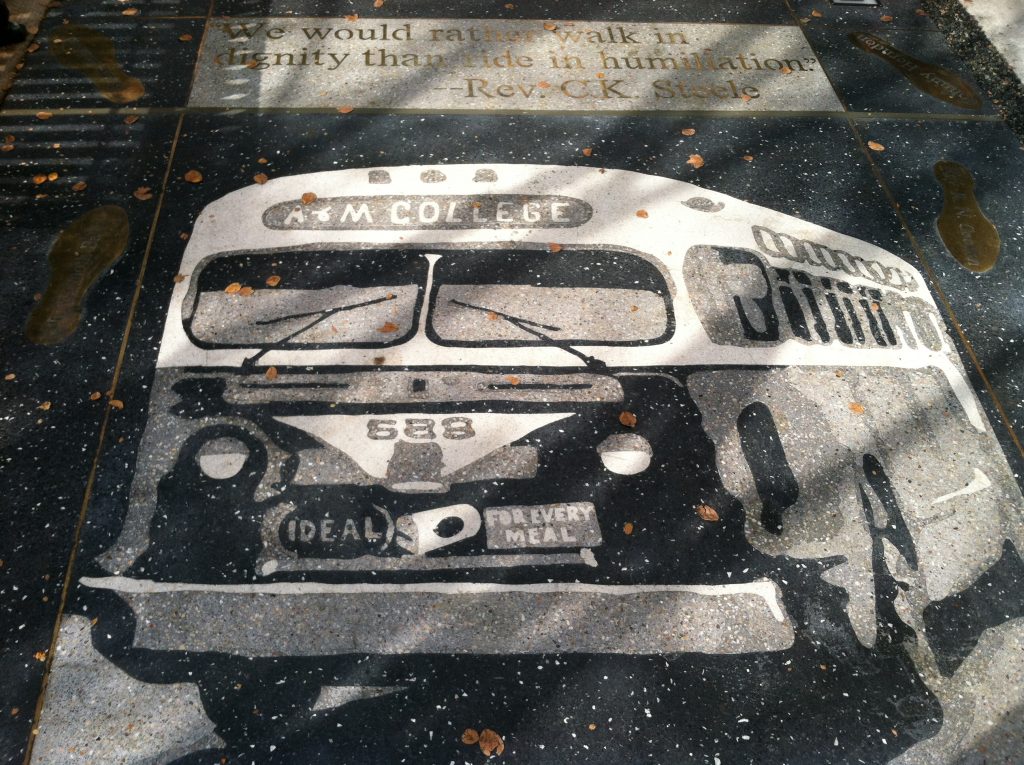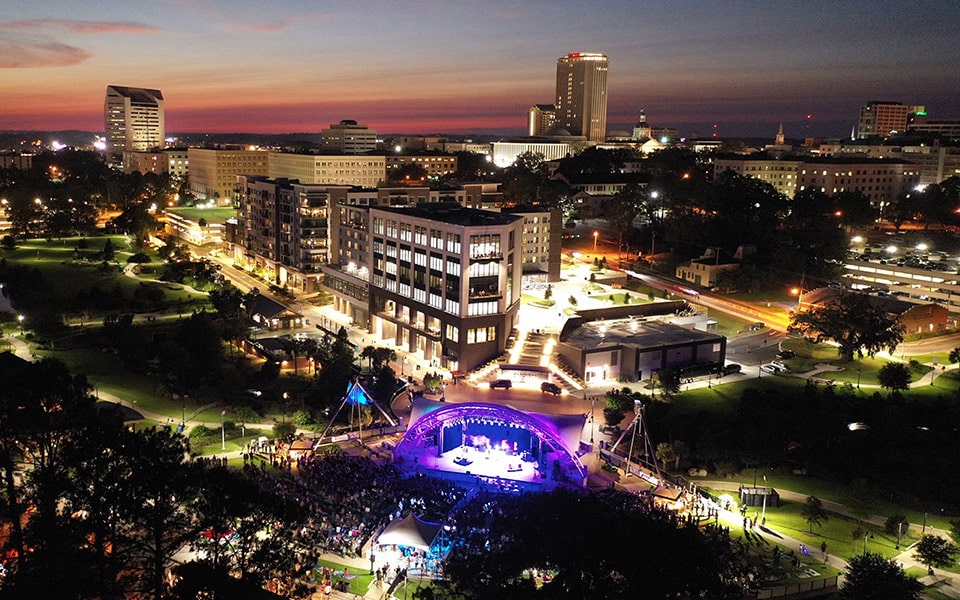
Spotlight on: Civil Rights in Tallahassee
The Civil Rights Movement is a core part of Tallahassee’s history. During this time, students from Florida Agricultural and Mechanical University (FAMU) partnered with local leaders, high school students, and Florida State University students to protest against unequal treatment under the law. Their history is our history, and their actions were crucial in the larger Civil Rights Movement, garnering the attention of Dr. Martin Luther King Jr., and the nation. Tallahassee’s Civil Rights Memorial offers a look at the defining moments of that history, and how we can explore it today.

Tallahassee Civil Rights Memorial
The Tallahassee Civil Rights Memorial sits on the former site of the Leon County Jail, now known as Cascades Historical Plaza. The memorial is located at the southeast corner of East Gaines and South Gadsden St., adjacent to the AC Hotel in downtown Tallahassee. The jail drew national attention in the 1960s when a group of civil rights activists held a nonviolent “jail-in” to protest segregation. The exhibit honors the courageous men and women who led the jail-in and interprets other key events in Tallahassee’s civil rights history. The structure uses corten steel backed by stainless steel, creating visual contrast between dark rust and silver colors. The largest panel on the front side commemorates the jail-in, and auxiliary panels include images and text that mark the events leading up to and following the jail-in. The reverse side of the exhibit includes a reproduction of a letter from Dr. Martin Luther King, Jr. sent to Tallahassee activists in 1960 and lists the names of Tallahassee’s civil rights “foot soldiers.”
May 26, 1956 – Tallahassee Bus Boycott Begins
On this day, FAMU students Carrie Patterson and Wilhelmina Jakes refused to give up their seats on the bus, and their arrests marked the start of the Tallahassee Bus Boycott. Soon after, Bethel Missionary Baptist Church Reverend C.K. Steele and Robert Saunders created the Inter-Civic Council to coordinate the boycott and negotiate with the City. During the boycott, Black citizens refused to use public buses, and instead coordinated carpools for transportation. The boycott ended in December 1956 after the US Supreme Court ruled that segregation on public buses was unconstitutional, and the City repealed its segregated seating ordinance. C.K. Steele Plaza was named in his honor, and a historic marker on FAMU’s campus remembers Jakes and Patterson for their bravery.
1960 Sit-In at Woolworths
In February 1960, the Tallahassee Congress of Racial Equality (CORE) planned two sit-ins at the local Woolworths in downtown Tallahassee. On February 20th, during the second sit-in, 17 demonstrators- mostly FAMU students- sat at the counter and refused to move. In the end, 11 students were arrested, found guilty and given the option to pay a $300 fine or spend 60 days in jail. The Tallahassee Jail-In began after eight students chose jail and was the first Jail-In of the Civil Rights Movement. Today, the Tallahassee Leon County Civil Rights Heritage Walk pays homage to the students, also called “foot-soldiers,” who participated in the sit-ins, bus boycotts, and demonstrations.

Florida Memory (December 6, 1960). Boycott and picketing of downtown stores – Tallahassee, Florida.
March-May 1960 Tallahassee Jail-In
Among the eight students who were arrested at the Woolworth Sit-Ins were sisters Patricia Stephens Due and Priscilla Stephens. Both were lead organizers with the Tallahassee CORE. Also arrested was high school student Henry Steele- son of Reverend C.K. Steele. Their jail-in garnered national attention, partially thanks to Jackie Robinson writing about the protests in his newspaper column and sending letters to the students. Martin Luther King Jr. also wrote to Rev. C.K. Steele to voice his admiration of the students’ actions. Once the students served their time, First Lady Eleanor Roosevelt organized several dinners to raise funds for the CORE students who lead the nation’s first jail-in. The Grove Museum offers in depth virtual tours that follow the impact of the Stephens Sisters, as well as a look at correspondence they received in jail.

The Grove Museum, Tallahassee.
June 1961- Tallahassee Ten
In June 1961, Interfaith Freedom Riders travelled from Washington, D.C to Tallahassee, Florida. Their trip was part of a larger challenge to segregated interstate buses. After a successful arrival, they headed to the airport to return home, but after attempting to be served at a segregated airport restaurant, all ten were arrested for unlawful assembly. They became known nationwide as the Tallahassee Ten.

Florida Memory. (June 16, 1961). Priscilla Stephens (later Kruize), from CORE, and Reverend Petty D. McKinney, from Nyack, N.Y., in the back of a Tallahassee police car.
Summer of 1963 Theater Protests
The summer of 1963 was a crucial time for Tallahassee Civil Rights Activists. It was a year before the landmark Civil Rights Act that hundreds of students from FAMU protested segregation in downtown Tallahassee. The main location for these demonstrations was the State Theatre on Monroe street. The segregated theatre became the site of dozens of arrests on May 30, 1963, and another 350 between September 14-16, 1963. So many students were arrested that the Leon County fairgrounds became an overflow jail site. Today, a historical marker stands at the Fairgrounds with the names of some of the core students that fought for equality that summer.

Florida Memory. (May 30, 1963). Patricia Stephens Due being arrested after defying restraining order with others at the State Theatre in Tallahassee.
Governor LeRoy Collins 1955-1961
LeRoy Collins became the Governor of Florida in 1955 during the height of the Civil Rights Movement. While he campaigned as a supporter of segregation, his actions while in office reflected a shift in perspective that provided the legal groundwork for integration. On March 20, 1960, he delivered a speech to all Floridians rejecting segregation as “morally wrong” and “undemocratic” after the wave of sit-ins held in Tallahassee and throughout the State. His stance helped increase public support for integration in all public spaces, which would become law with the Civil Rights Act of 1964. Governor Collins was present for the signing and would go on to lead the Community Relations Service created to support its implementation. Today, the Grove Museum offers a full history of the Civil Rights Movement and how local students and politicians shaped its success.

Florida Memory (July 2, 1964) Former Florida Governor LeRoy Collins with President Lyndon B. Johnson during ceremony marking passage of the Civil Rights Act.
Whether you explore the Civil Rights Heritage Walk, the Grove Museum, or the variety of historical markers, Tallahassee offers plenty of opportunities to learn from the brave activists and students that fought for equality.


